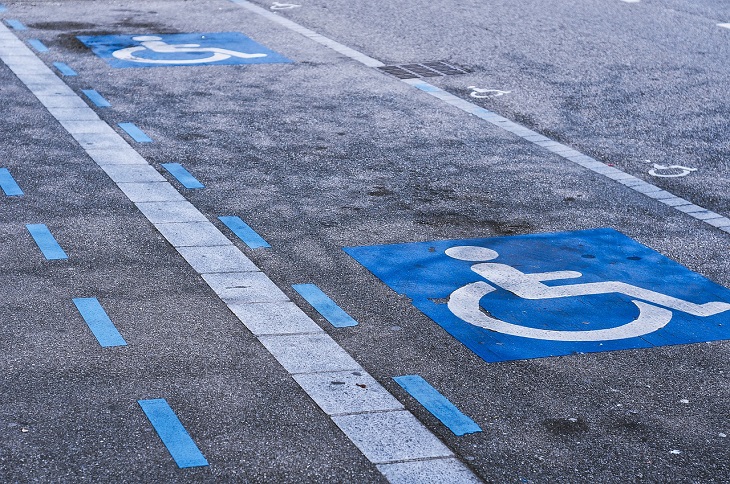Filling out official government forms can be stressful for anyone, but even more so if you have a disability. Whether you have health conditions that impact your stress levels or mobility issues that limit your dexterity, it can be anxiety-inducing to fill out your disabled parking permit form. You may be wondering, “What if I do something wrong? What happens if I make a mistake on my disability parking permit application form? What if the DMV doesn’t approve my application?”
Try not to stress! The state DMVs know how important disabled parking is and want to make sure people in need have the correct permit, so they’re on your side. To help you out, below are some useful tips for the application process – plus, what to do if you happen to make a mistake on your forms.
Tips on how to fill out a disability parking permit application form
Each state controls its own disabled parking permits, but the process works the same almost everywhere. It’s fairly simple and shouldn’t take up too much of your time, but it still helps to be prepared.
Here are a few tips to help you tackle the process.
Take your time
You’ll feel calmer and more capable if you take your time when sitting down to complete your disability permit application. Read through everything first and then fill out the form slowly, ensuring you enter the correct information in the right place. That way, you’ll know what’s required and you’ll be prepared.
Enlist a friend or carer to help
Don’t feel like you need to complete all of the application yourself. It’s completely OK to ask for help from a friend, family member, or carer. They can sit with you and assist, ensuring you’re able to fill out all of the information as needed.
If you’re not able to fill out the form yourself, your helper can enter the information on your behalf.

Gather all the documents you need in advance
Completing your application will be easier if you have everything you need in one place. That way, you won’t be scrambling around to find your license or other necessary details.
First, you’ll need the right paperwork. Wondering where to get a disability parking permit application form? Because disabled parking is controlled by individual states, the easiest way is to look at the Department of Motor Vehicles website for the state you live in or give them a quick phone call.
In addition, you’ll generally need your driver’s license number; your completed medical certification from a medical professional, certifying your eligibility; and the make, model, and license plate number of your car. Don’t worry about the medical certification, though, since it’s easy to obtain for anyone with a qualifying medical condition.
Print out an extra copy
If you feel nervous that you’ll make a mistake with your paperwork, print out an extra form in advance, in case you need it. Or keep some white correction fluid or tape nearby so you can erase any mistakes and write over them.
Understand the next steps
After you’ve completed your application, be sure you know what happens next! Make sure you know the answers to each question:
Where do I submit my disability parking permit application form?
The answer will depend on your state, but you’ll usually need to submit via email or fax, or drop it off in person at your local DMV office.
Where do I mail my DMV application for a disabled person placard?
Usually, this will be sent to your state’s DMV head office. If you’re unsure of their address, check their website or give them a call to double-check.
What happens if I make a mistake on my disability parking permit application form?
So you’ve completed your application, but you look over it one more time and see that you’ve made a mistake. Or you realize that you’ve forgotten something or mailed your application to the wrong place. What can you do? It’s all going to be OK – here’s what to do if something has gone wrong.
Remain calm
First, try to relax! No matter what mistake you’ve made, it’s probably not as big of a deal as you think it is. Take a few deep breaths, try to remain calm, and work out how to fix the issue. A mistake isn’t going to jeopardize your disability permit application, so don’t worry. Small problems like this are easier to solve when you’re feeling calm and level-headed.

Start over
If you’ve made a mistake with your application, it’s always OK to start over! Simply grab a new application and complete it one more time, discarding the previous one.
Call the DMV and explain the situation
When in doubt, always call or email the DMV for clarification or to explain what’s happened. Maybe you’ve entered your address wrong, forgot to include your application fee, or even sent through your application to the wrong address – whatever the issue, the DMV can give you the correct answers.
Explain to a staff member what mistake has been made and they’ll explain how it can be fixed. Everyone makes mistakes, and you’re probably not the first person to call them about the issue! This also applies if you’ve accidentally lost your disabled permit, since they can give you advice on how to replace it.
Once the problem is solved, your application will be processed and you’ll have your new disability permit before you know it!
Featured image by JESHOOTS-com on Pixabay







